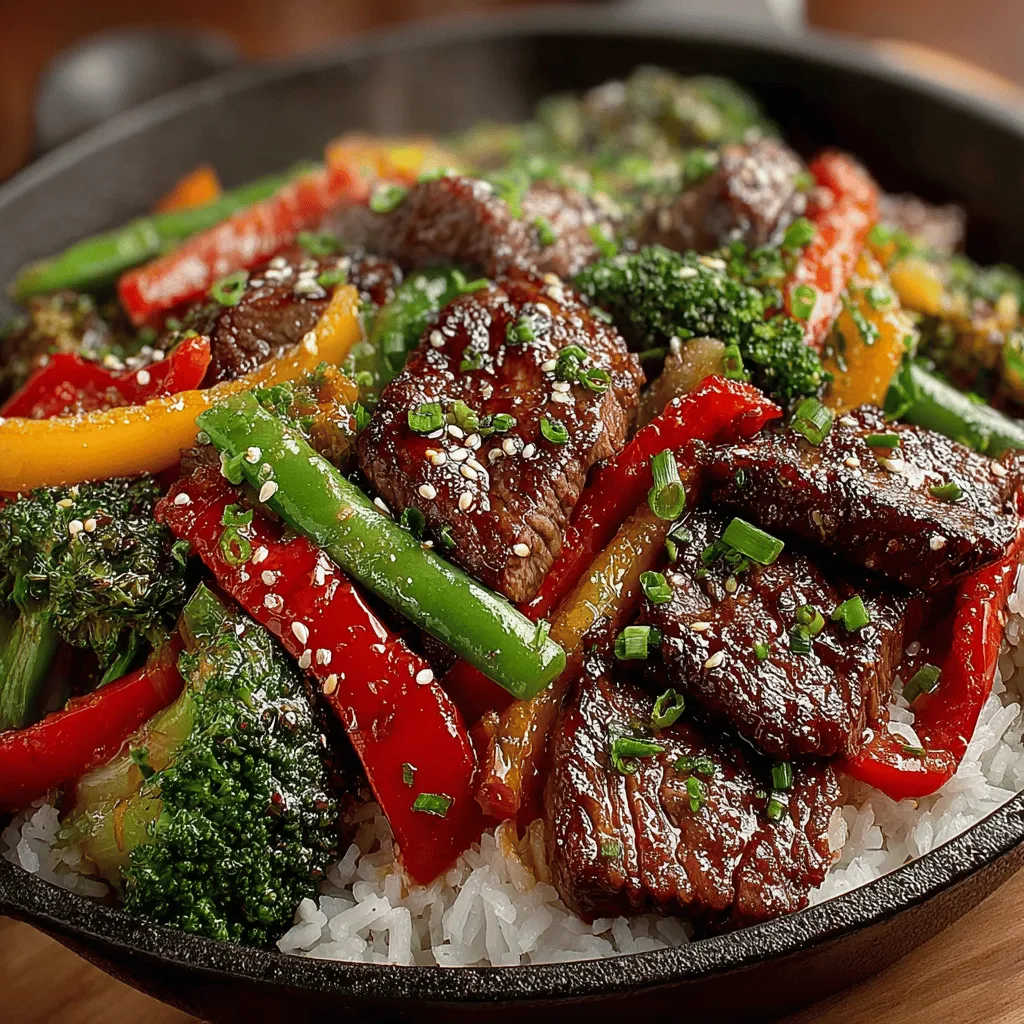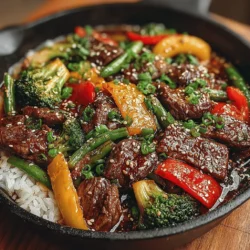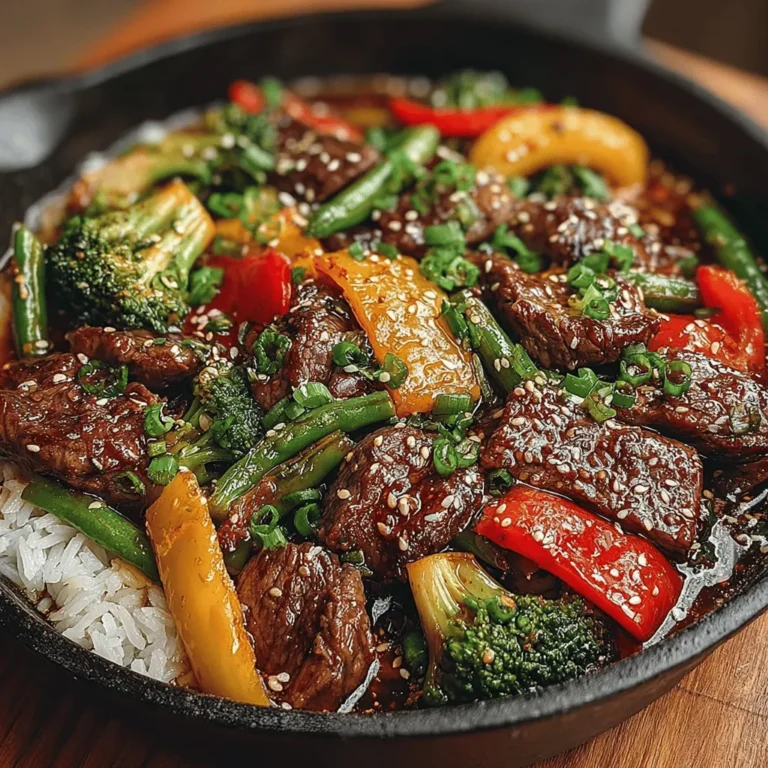Introduction
In today’s fast-paced world, the quest for quick yet satisfying meals has become a priority for many home cooks. With busy schedules and the constant juggle between work, family, and personal time, finding a weeknight dinner option that is both nutritious and easy to prepare is essential. Enter the Quick and Zesty Beef & Veggie Stir-Fry, a dish that perfectly fits the bill. This recipe not only comes together in a matter of minutes but also delivers a delicious balance of protein and vibrant vegetables, making it a wholesome choice for dinner.
Stir-fries have long been celebrated for their ability to combine fresh ingredients with bold flavors in a relatively short cooking time. The Quick and Zesty Beef & Veggie Stir-Fry showcases this culinary technique, allowing you to enjoy a delightful meal without spending hours in the kitchen. With tender slices of beef, a colorful medley of vegetables, and a zesty sauce, this dish is an ideal solution for those busy weeknights when time is of the essence yet nutrition remains a priority.
Understanding Stir-Fry: A Culinary Technique
Stir-frying is a cooking method that originated in China over two millennia ago. It involves cooking small, uniform pieces of food quickly over high heat in a small amount of oil. This technique allows for rapid cooking, which helps to preserve the color, flavor, and nutritional content of the ingredients. The high heat creates a unique texture, giving the food a delightful char while maintaining its juiciness.
One of the significant benefits of stir-frying is the speed at which meals can be prepared. With a prepped mise en place, a stir-fry can be cooked in as little as 10 to 15 minutes. This not only saves time but also retains the vibrant colors and crunch of the vegetables, resulting in a dish that is as visually appealing as it is delicious. Furthermore, the quick cooking process helps to lock in the flavors, allowing each ingredient to shine through.
To achieve the best results when stir-frying, proper ingredient preparation is crucial. All ingredients should be cut into uniform sizes to ensure even cooking. Additionally, the use of high heat is essential, as it allows for the rapid caramelization of sugars and the development of complex flavors. In this Quick and Zesty Beef & Veggie Stir-Fry, we will explore how these principles come together to create a delicious dish.
Ingredients Breakdown
The success of any stir-fry lies in its ingredients. Each component plays a vital role in building flavor, texture, and nutritional value. Below is a breakdown of the key ingredients used in the Quick and Zesty Beef & Veggie Stir-Fry.
Beef Sirloin
When it comes to stir-frying, choosing the right cut of beef is essential. Beef sirloin is a popular choice due to its tenderness and rich flavor. It is leaner than some other cuts, making it a healthier option while still providing a satisfying protein source. For the best results, look for sirloin that is well-marbled, as the fat will contribute to the overall flavor and tenderness of the meat.
Soy Sauce and Oyster Sauce
In Asian cuisine, sauces are pivotal in adding depth and umami to dishes. Soy sauce serves as the primary seasoning in this stir-fry, imparting a savory and slightly salty flavor. Oyster sauce, on the other hand, adds a rich, sweet undertone that enhances the overall taste profile. Together, these sauces create a harmonious balance that elevates the dish to new heights.
Vegetables
The vegetables in this stir-fry not only add color and crunch but also provide a wealth of nutritional benefits. Broccoli is rich in vitamins K and C, while bell peppers are an excellent source of antioxidants. Snap peas contribute a satisfying sweetness and are high in fiber, and carrots add a natural sweetness along with beta-carotene. This combination ensures that the dish is not only delicious but also packed with essential nutrients.
Aromatics
Garlic and ginger are two key aromatics that play a significant role in Asian cooking. Garlic adds a pungent flavor that enhances the overall taste, while ginger provides a warm, slightly spicy note. Together, they create a fragrant base that complements the beef and vegetables beautifully.
Sesame Oil
To finish off the stir-fry, a drizzle of sesame oil adds richness and a nutty flavor that rounds out the dish. This oil is often used in Asian cuisines for its distinctive taste, and it can elevate the overall flavor profile of your stir-fry.
Ingredient Substitutions
For those with dietary preferences or restrictions, there are numerous substitutions available to customize this stir-fry. For a vegetarian alternative, consider using tofu or tempeh as a protein source. You can also swap out the beef for chicken or shrimp, depending on your preference. Additionally, feel free to experiment with different vegetables based on what is in season or available in your pantry.
Preparation Steps: A Detailed Guide
Marinating the Beef
Marinating the beef is a crucial step that enhances both flavor and tenderness. A simple marinade made from soy sauce, oyster sauce, and a touch of sesame oil can work wonders. Allow the beef to marinate for at least 15-30 minutes, or even overnight if time permits. This process allows the meat to absorb the flavors, resulting in a more delicious stir-fry.
Preparing the Vegetables
While the beef is marinating, it’s essential to prepare the vegetables. Uniform cuts are critical for even cooking, so take the time to slice the broccoli, bell peppers, snap peas, and carrots into similar sizes. This ensures that everything cooks at the same rate, preventing some ingredients from becoming overcooked while others remain underdone.
With these initial steps taken care of, you will be well on your way to creating a Quick and Zesty Beef & Veggie Stir-Fry that is sure to please everyone at the dinner table. Stay tuned for the next part of the recipe, where we’ll dive into the cooking process and bring all these ingredients together for a satisfying meal.

Tips for Efficient Vegetable Prep
Preparing vegetables efficiently is key to a successful stir-fry. Here are some practical tips to streamline your vegetable prep:
1. Choose the Right Tools: A sharp knife and a sturdy cutting board will speed up your chopping. A mandoline slicer can be used for uniform cuts, especially for carrots and bell peppers.
2. Wash and Dry: Rinse your vegetables thoroughly to remove any dirt or pesticides. Pat them dry with a clean towel; excess moisture can cause splattering during cooking.
3. Uniform Cutting: Cut vegetables into similar sizes to ensure even cooking. For instance, slice bell peppers and zucchini into thin strips, while broccoli can be cut into small, bite-sized florets.
4. Prep Ahead: If you’re short on time, consider prepping your veggies in advance. Store them in airtight containers in the fridge until you’re ready to cook.
5. Group by Cooking Time: Separate your vegetables based on how long they take to cook. This allows you to add them to the pan at the right time to maintain their color and crunch.
Heating the Pan
Heating your pan properly is crucial for achieving that perfect stir-fry. Here’s how to do it:
– Use a Wok or Large Skillet: A wok is ideal due to its high sides and ability to distribute heat evenly. If you don’t have a wok, a large skillet will work just fine.
– Preheat: Start by preheating your pan on high heat for about 2-3 minutes. You want it to be hot enough that a drop of water sizzles and evaporates quickly.
– Add Oil: Once the pan is hot, add your chosen oil—preferably a high smoke point oil like canola, peanut, or grapeseed oil. Swirl the oil around to coat the surface.
Ideal Cooking Temperatures and Oil Selection
The best stir-fry is achieved at high temperatures, usually between 400°F to 450°F (204°C to 232°C). Here’s how to select your oil:
– High Smoke Point: Choose oils that can withstand high temperatures without burning. Canola, peanut, and sunflower oils are excellent choices.
– Flavor Consideration: While neutral oils are best for frying, adding a bit of sesame oil towards the end can enhance flavor without compromising the cooking process.
Cooking Process
Step-by-Step Breakdown of Cooking the Beef for Optimal Sear
1. Prepare the Beef: Slice your beef against the grain into thin strips. This helps to tenderize the meat and allows it to cook quickly.
2. Marinate (Optional): If time permits, marinate the beef in a mix of soy sauce, cornstarch, and a dash of sesame oil for about 15-30 minutes. This will enhance flavor and tenderness.
3. Sear the Beef:
– Add the marinated beef to the hot pan in a single layer. Avoid overcrowding, as this can cause the meat to steam rather than sear.
– Let it cook undisturbed for about 1-2 minutes until browned, then stir-fry for an additional 1-2 minutes until cooked through.
Timing and Techniques for Adding Aromatics and Vegetables
– Aromatics First: Once the beef is cooked, remove it from the pan and set it aside. In the same pan, add minced garlic and ginger, stirring quickly to avoid burning. This usually takes about 30 seconds.
– Add Vegetables: Start with vegetables that take longer to cook, such as carrots and bell peppers. Stir-fry for about 2-3 minutes before adding quicker-cooking veggies like zucchini and broccoli.
– Regulate Heat: Keep your pan on high heat throughout the cooking process to maintain the vibrant color and crispness of the vegetables.
Balancing Cooking Times to Keep Vegetables Vibrant and Crisp
– Layering: Add vegetables in stages according to their cooking times. For instance, add broccoli after the carrots have softened slightly.
– Quick Toss: Stir-fry for a brief time, just enough for the vegetables to retain their crunch, typically around 3-5 minutes total.
– Final Touches: Return the beef to the pan, pour in your sauce, and toss everything together for an additional minute to meld the flavors.
Serving Suggestions
Best Practices for Plating the Stir-Fry
– Choose a Wide Plate: Use a wide, shallow bowl or plate to allow for a beautiful presentation. The colors of the vegetables should be visible, creating an enticing visual.
– Layering: Start with a base of rice or noodles, then pile the stir-fry on top, ensuring an even distribution of beef and vegetables.
Pairing Options: Rice, Noodles, and Alternative Grain Options
– Rice: Jasmine or basmati rice pairs beautifully with this stir-fry, absorbing the flavors of the sauce.
– Noodles: For a heartier meal, consider serving over soba or rice noodles. Both options are quick to prepare and hold up well with the stir-fry.
– Alternative Grains: Quinoa or cauliflower rice can be excellent low-carb alternatives, providing a unique twist to the traditional stir-fry.
Garnishing Ideas: Enhancing Presentation with Green Onions and Sesame Seeds
– Green Onions: Thinly slice green onions and sprinkle them on top for freshness and a pop of color.
– Sesame Seeds: Toasted sesame seeds add a nutty flavor and a delightful crunch. Sprinkle them generously before serving.
Suggestions for Side Dishes That Complement the Stir-Fry
– Spring Rolls: Crisp vegetable spring rolls make a great appetizer alongside the stir-fry.
– Miso Soup: A light miso soup pairs well, balancing the meal without overwhelming it.
– Edamame: Steamed edamame pods sprinkled with sea salt offer a nutritious and satisfying side.
Nutritional Profile of Quick and Zesty Beef & Veggie Stir-Fry
Analysis of the Dish’s Macronutrient Content
A typical serving of Quick and Zesty Beef & Veggie Stir-Fry offers a balanced macronutrient profile:
– Protein: The beef provides a significant protein boost, essential for muscle repair and growth.
– Carbohydrates: Depending on your choice of base (rice or noodles), you can adjust the carbohydrate content to fit your dietary goals.
– Fats: The dish contains healthy fats from the oil used and any nuts or seeds added for garnish, contributing to satiety.
Health Benefits of the Ingredients Used
– Vegetables: Packed with vitamins, minerals, and fiber, the mixed vegetables provide essential nutrients while being low in calories.
– Beef: A good source of iron and vitamin B12, beef supports energy levels and overall health.
– Low Calorie: This stir-fry is a low-calorie meal option, making it suitable for weight management.
Discussion on Portion Control and Serving Sizes
– Ideal Serving Size: A standard serving of the stir-fry is around one cup, which includes a balanced distribution of protein and vegetables.
– Mindful Eating: Using smaller plates can help control portions and prevent overeating, ensuring you enjoy the meal without the excess.
Variations and Customization
Ideas for Personalizing the Stir-Fry: Additional Vegetables and Protein Options
– Extra Veggies: Feel free to add snap peas, baby corn, or bell peppers for added color and crunch.
– Different Proteins: Swap out the beef for chicken, shrimp, or tofu for a vegetarian option. Each protein will bring a different flavor and texture.
Flavor Variations: Adding Spices or Sauces for Different Cuisines
– Thai Twist: Incorporate Thai basil and a splash of coconut milk to create a creamy, aromatic dish.
– Szechuan Style: Add Szechuan peppercorns and chili paste for a spicy kick that elevates the stir-fry.
Seasonal Variations: Using Seasonal Vegetables for Freshness
– Spring Vegetables: Use asparagus and peas in spring for a fresh taste.
– Autumn Varieties: Incorporate butternut squash and Brussels sprouts in the fall for a hearty, seasonal adaptation.
Conclusion
The Quick and Zesty Beef & Veggie Stir-Fry presents an appealing option for those looking for a quick yet nutritious meal. Its versatility allows for endless customization, ensuring that you can adapt it to suit your taste preferences and dietary needs. The stir-frying technique not only cooks food quickly but also preserves the vibrant colors and nutrients of the ingredients, making it an excellent choice for health-conscious cooks.
With its rich flavors and satisfying textures, this recipe encourages experimentation and personal touches, transforming simple ingredients into a delicious and wholesome dish. So gather your ingredients, fire up your pan, and enjoy the delightful experience of creating your own personalized stir-fry masterpiece!


